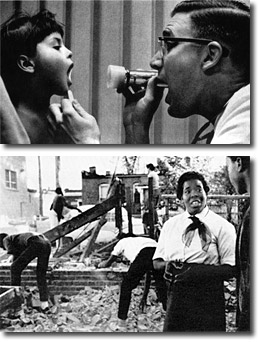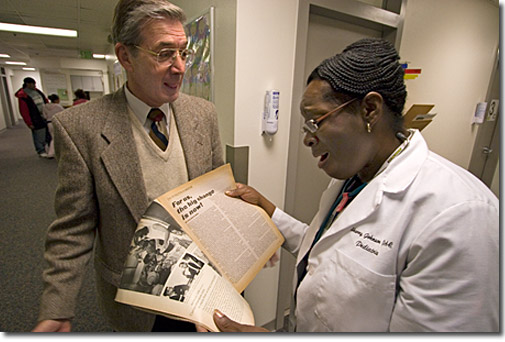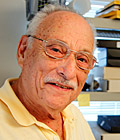Dr. John Sbarbaro "A New Kind of Care"

Top, Dr. John Sbarbaro checks four-year-old Linda Cruz for strep throat at the second free health clinic in the nation. Bottom, "the Center's environmental-health aide, Mrs. Sara Harmon … 31, from the slums, formerly worked as a maid to help support her six children. Now, she has a future." Photos by Bob Lerner. |

In Dec. 2005, Dr. Sbarbaro visited the Eastside Health Clinic that he helped found, as he does almost once a month. He ran into Physician's Assistant Sherry Johnson. As it turned out, Sherry is Sara Harmon's daughter. She chose medicine as a career because of her experience at the Eastside Health Clinic. She had never seen the LOOK article with her mom in it. To Dr. Sbarbaro's surprise, she told him that Sara was still alive and living close by. Photo by Bill Ganzel. All original material © 2006-2013 by Bill Ganzel, all rights reserved. |
|
Free community health clinics were brand new in 1967, part of President Lyndon Johnson's War on Poverty. Denver's Eastside Neighborhood Health Center was one of the first. LOOK portrayed Dr. John Sbarbaro, the medical director of the center, as a new kind of doc, who was much more idealistic than his colleagues. the article said that the doctors on the staff "get $12-$17,000 a year" when other doctors were making $35,000 and more. "As my wife [Marlene] has told me over and over again," he says now, "I never did get involved in money – much to my chagrin, and to her teasing. You know, [she says,] 'Did you ever really want to make a dollar?' Well, I made enough to make it happen, and so I just accepted the city's salary. And, every time you had a success … you're doing so much good – that it was just – you felt good about it, that's all." Sbarbaro thinks that, as he aged, he has become more moderate and then slightly conservative. Looking back, he believes the 1960s were a pivotal decade. "The 60s were [pivotal]. Looking back on it and recalling all the things I was involved with, and recalling everything I saw – yeah, one of the greatest 'change eras' ever. The Depression was the other one. I agree. I was a child of the Depression. Remember I came out in '36. My parents had nothing. And the 60s were the same thing. It was a social movement second to none. And I think what the problem is that some of the folks who were the major movers haven't moved from that era." |
Under the guidelines for the War on Poverty, for every doctor hired, the Health Center had to hire one community worker – from the community. Sara Harmon was a maid and a community "rabble rouser" when she was hired as an environmental health aide. It was her first professional job. Sbarbaro was impressed with Sara and kept promoting her. But when he finally moved to other jobs, Dr. Sbarbaro lost track of Sara – that is, until he and photographer Bill Ganzel went back to the Center with the LOOK magazine in hand. Sbarbaro volunteers his time at the clinic roughly once a month. As we walked around and folks asked what we were doing, one physician's assistant, Sherry Johnson, came up. We showed her the article and she exclaimed, "That's my Mom!" The photo was the one of Sara Harmon. The moment was captured in the photograph above. Sherry had actually decided to become a PA because of her childhood experiences as a patient at the clinic. In 2005, her mother was still alive and lived just a couple of miles away. That afternoon, we visited Sara and Sherry at Sara's suburban house. Both had fond memories of Dr. Sbarbaro and the Eastside Health Center. Dr. Sbarbaro died in August, 2011, after several months of illness. An endowed lecture series in public health was established at the Denver Health Foundation. |





